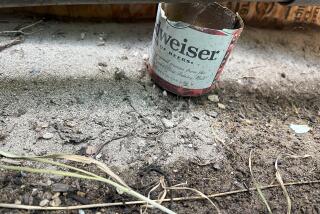Ricin letters more frightening than dangerous, evidence shows
- Share via
WASHINGTON — Over the last two months, authorities have seized a succession of letters laced with the toxin ricin intended for the CIA, President Obama and other public officials.
Viewed as copycat events by some investigators, the letters have generated high-profile coverage on television and were widely reported by other media organizations, including the nation’s major newspapers.
But experts say the ricin that has been sent through the mail has posed little health risk for two reasons.
One is that considerable laboratory expertise would be needed to purify, concentrate and dry the toxin in a way that makes it potentially lethal by inhalation. And, compared with another feared bioterrorism agent, anthrax, ricin is not nearly as toxic when released through the air.
Not a single person exposed to ricin sent through the mail this year — or ever, authorities say — has died or been found by doctors to have been sickened by it. According to “Bioterrorism,” a 2012 book edited by microbiologist Steven A. Morse of U.S. Centers for Disease Control and Prevention, “There are no documented cases.” However, the book warned: “Though ricin is not considered an effective weapon of mass destruction, its potential as a weapon of terror cannot be discounted.”
What distinguishes ricin from other Category B bioterrorism agents listed by the CDC is that it is easily obtained. All that a would-be terrorist needs to get started is to buy or harvest some castor beans, which contain the toxin. Sales are made legally over the Internet and at local nurseries. Investigators note that the beans’ progenitors, attractive ornamental plants of the Ricinus communis species, are commonly used for landscaping, even at various federal buildings.
On Wednesday, the New York Police Department said in a written statement that three male officers who dealt with one of the recent letters — addressed to Mayor Michael R. Bloomberg — were “being examined for minor symptoms of ricin exposure.”
But on Friday, a department spokesman, Paul J. Browne, acknowledged that extensive hospital testing of the three had found no sign of ricin in them.
“There was no evidence of ricin exposure,” Browne said in an interview, adding that results of the medical tests, which he said were concluded Wednesday, “were not indicative of any ricin side effects.”
Separate tests by the National Bioforensic Analysis Center in Frederick, Md., found only minute concentrations of ricin in the letters addressed to Obama, Bloomberg and a Washington, D.C.-based gun-control organization affiliated with the mayor, according to people familiar with the matter.
Referring to the tests of the ricin letters that were sent to Bloomberg and Mayors Against Illegal Guns, Browne said: “The national lab had told us that the ricin was crude and low-level — crudely produced. This looks like somebody who may just have smashed up a bunch of [castor] beans.”
A spokeswoman for the FBI, Ayn S. Dietrich, confirmed that no illnesses had been reported in connection with a ricin-laced letter sent in early May to a U.S. District Court judge in Spokane, Wash., or with four “similar letters,” including one addressed to Obama and another to the CIA in Langley, Va. A suspect from Washington state has been indicted on a charge of mailing threatening communications to the judge.
Robert A. Fein, a psychologist who has studied assassinations of public figures for the federal government, said that the heavy public focus on the ricin letters might be gratifying to some of the perpetrators.
“For someone who is angry and doesn’t want to be a nobody, it’s a way to get attention,” Fein said.
Though the precise lethal dose of inhaled ricin for humans has not been established, estimates have been made based on testing of mice. Swallowing concentrated ricin or castor beans can cause harm to humans. A 1985 medical journal article described 751 cases of individuals who ingested castor beans, resulting in 14 fatalities, a death rate of 1.9%.
The authors of “Bioterrorism” said that “ricin’s notoriety is likely driven by the ready availability of castor beans, press coverage and popularization on the Internet.”
More to Read
Sign up for Essential California
The most important California stories and recommendations in your inbox every morning.
You may occasionally receive promotional content from the Los Angeles Times.











